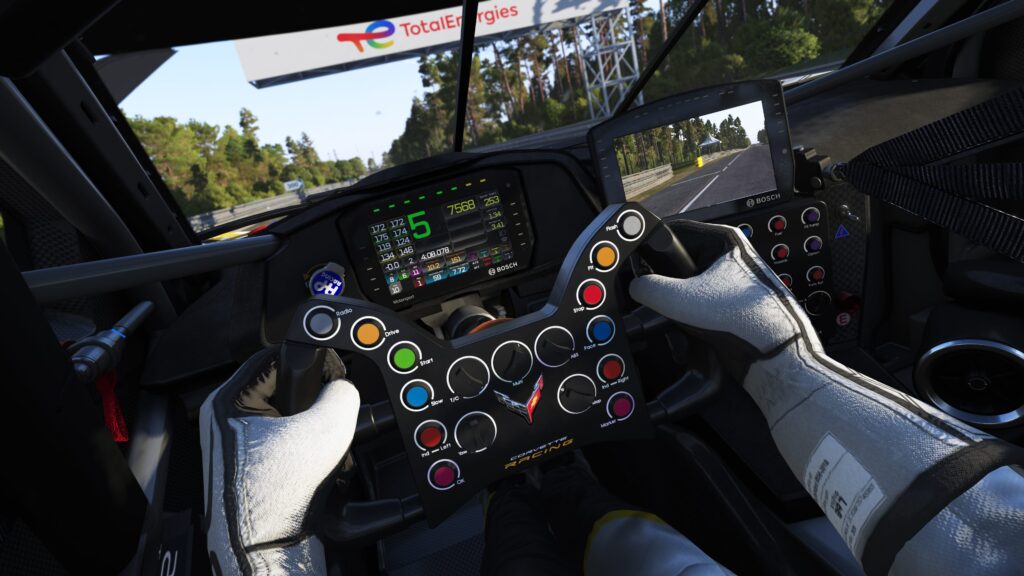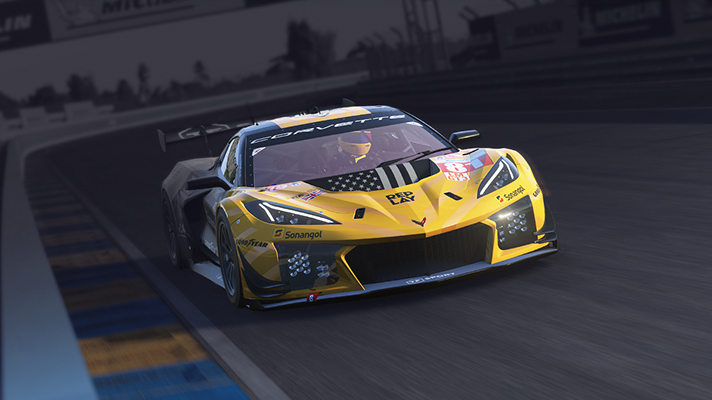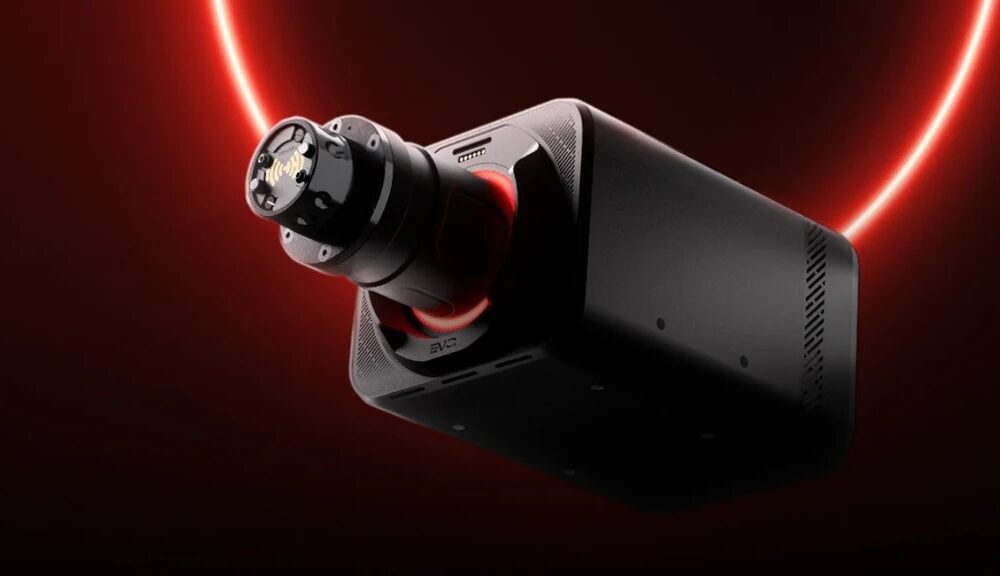Assetto Corsa Competizione has been the king of GT3 racing since it launched in 2019, though Le Mans Ultimate is doing its best to wrestle away the crown with its recent LMGT3 updates. Both sims have way more to offer than just GT3 racers, though, so Coach Dave Academy decided to pit both sims against each other to explore their relative strengths and weaknesses.
Graphics
ACC utilised, for better or worse, the Unreal 4 graphics engine, which produced amazing looking visuals for those who had a beefy enough PC to run it. For those with less powerful PCs, though, the game is decidedly less pretty due to the lower-end graphics needed to allow it to run at a decent frame rate. The game also struggles with anti-aliasing, causing jagged edges, while ghosting is prevalent.
Le Mans Ultimate uses the much older isiMotor engine utilised by rFactor 2, though the Studio 397 team has upgraded it to look bang up-to-date. The lighting looks great, if not better than a fully tuned-up ACC. It’s generally much easier to run now that it has several optimisation updates than Kunos’ baby, especially if you turn down the ‘visible cars’ setting. Its visuals are a bit better balanced overall.
Compatibility
ACC stretches over a wider user base compared with Le Mans Ultimate right now, as it is available on consoles as well as on PC. It can be utilised with a keyboard, controller, or steering wheel, and arguably comes with better out-of-the-box controller profiles than LMU.
LMU is currently only available for the PC and can be used with the same peripherals as ACC. While it’s not quite as easy to use as ACC out-of-the-box, there are plenty of settings to dial it to your liking. LMU are constantly updating compatibility and profiles for better out-of-the-box performances, so watch this space.
Handling and Physics

While both sims feature a wide range of vehicles, we’ll focus on a class both have in common: GT3. Even then, there are differences, as LMU uses LMGT3 vehicles, which have different power and aero levels than the SRO GT3 machines. That said, ACC handles the feeling of weight very well right now, probably better than LMU’s cars, with the sim portraying them as the heavy GT cars they are.
The suspension model is arguably ACC’s biggest weakness, as large impacts unsettle the car way more than they should. This is something Le Mans Ultimate have certainly nailed. No more crazy bouncing or pogoing from the suspension. ACC’s braking model is also unrealistic, as you have to mash the pedal as hard as you can before trying to trail brake off, something that doesn’t happen in real life so much. LMU is far superior in these regards, with the car feeling more natural as a result, though cars can feel a little lighter than they should.
ACC’s tyre model was a little ahead of LMU before the latter’s latest update, though the latter is now arguably ahead, especially as the focus on constantly having perfect pressures on ACC is inauthentic. Both tyre models demand the driver to take care of the rubber during a stint and will punish you if you don’t.
Gain seconds in lap time with our incredible Le Mans Ultimate setups developed by professional sim racers and qualified engineers.
- Setups
- Data
- Lap Guides
LMU also differs from ACC in that its GT3 cars use virtual energy to work out fuel, while ACC uses more traditional fuel calculations. VE has been developed by WEC organisers ACO to match different vehicle engines to ensure none has an efficiency advantage due to their engine type.
While fuel is a part of the calculation, it’s not all, and the VE figure is normally higher than that of the fuel level. This means you need to keep an eye on the VE level as well as the fuel. If you have too little fuel but enough VE, you’ll run out. Run out of VE and not fuel, and you’ll get a stop-and-go penalty for exceeding the VE limit. You don’t have to worry about this in ACC and can focus purely on the fuel level and usage of your vehicle.
Coach Dave Academy founder and professional GT3 racer Dave Perel reckons that with a little more tweaking, namely reducing aero load and tweaking the tyre model to offer a little extra front-end grip, LMUs GT3s can be the industry benchmark.
Weather
Both Sims have fully dynamic weather systems. While neither have realistic wet lines, in which the areas off the usual dry racing line feature more grip due to the heavily rubbered road being more slippery in the wet, ACC’s tracks at least have puddles that appear as the track gets more saturated.
LMU’s weather system doesn’t feature any kind of puddles or other dangers, with the track getting wet similarly around the lap rather than in specific areas. It does feature greater variability in terms of weather throughout a session, though, with the option to manually configure how the weather changes every 15 minutes when configuring your offline Race Weekends.
ACC, meanwhile, only features a ‘variability’ setting, which leaves you at the mercy of how the game wants to alter the weather. Both weather systems need significant development to be as good as iRacing’s market-leading setup, though they at least offer a little extra dynamic nature to races.
Force Feedback

As far as FFB goes, Le Mans Ultimate is already ahead of ACC. LMU provides a more engaging and active experience, though it could do with a little more feeling in low-speed bends and the feel of tyre load at high speed. The latest GT3 tyre update significantly improved the former element, though.
The FFB in ACC gives a good feel of steering weight, though it lacks the overall depth to provide an engaging and fun driving experience. It’s solid, but it would be nice if a little more came through the wheel in terms of grip loss and rotation. Aside from the general steering force, LMU also has excellent FFB effects for the ABS system and wheel lockups.
The wheel oscillates when the ABS kicks in to let you know when you need to back off the brakes a little, while vibrations will amplify through the wheel the more you flatspot your tyres. These elements add that little extra immersion, and it is all the more better for it. ACC’s FFB is serviceable, but the extra detail LMU offers makes a difference.
Realism
Neither of ACC’s or LMU’s damage models stand out from one another, with both featuring mechanical damage that covers aero, suspension, and body areas, as well as tyre damage such as flatspots. Continue to abuse a flatspotted tyre, and both sims will punish you with a puncture.
Both sims are based on real-life championships, the GT World Challenge for ACC and the World Endurance Championship for LMU, and both do a good job of incorporating real-life rules for the most part. Both currently lack any kind of safety car or full-course yellow feature, ruling out a critical part of real racing from taking place.
LMU does a great job of incorporating strategy into races through the implementation of virtual energy, with drivers able to make a difference by saving fuel. In ACC, fuel is largely covered by tyre changes, while in LMU, you can make up much more time by using less fuel. Lifting and coasting is, therefore a key talent to learn, especially when racing in longer enduros online.
- LMU currently features all the cars, tracks and drivers from the 2023 WEC season and most of the content from the 2024 WEC campaign, which is set to be completed in May 2025
- This includes all special liveries used through the year, such as race-specific ones at Le Mans and other events
- ACC currently features a much wider variety of content, with all cars and liveries from every GTWCE season between 2018 and 2024
- Some race-specific liveries are included from teams, but not all (Schemes used in IGTC events like the Spa 24h are favoured for inclusion in this regard)
- ACC features all the tracks featured in the 2018/2019 seasons, though it’s missing some (such as Magny Cours and Hockenheimring) from later seasons and DLCs (like GT Challenge America, with only three of the seven tracks on the 2021 calendar included)
ACC also has a custom livery feature, allowing drivers to create liveries not featured natively in the game, unlike LMU, which currently doesn’t have one but will do in May 2025.
Competitions
LMU’s in-game racing system is far superior to ACC’s for the most part, though it’s currently lacking a key element of online competition: driver swaps. This feature is set to debut in May, though, so this will soon change.
LMU has a comprehensive in-game ranking system that consists of a range of daily and weekly races, while buying a RaceControl Pro subscription ($7.99 a month or $48 a year) will get you access to Championships.
- These are structured races that take place over six weeks, with the driver that scores the most points winning the championship at season’s end
- Open and fixed setup series are available to enter; a maximum of four can be run at a time
ACC doesn’t feature much of an in-game online racing system, with only Competition servers being offered. These come with a fairly limited scope compared to LMUs dailies, so you’ll likely need to rely on third-party services to get your online racing fix.
- Once LMU has driver swaps and gone through more of a maturity phase, the plan is for it to host Virtual Le Mans, much like its rFactor 2 forerunner once did
- ACC has acted as the platform for the official SRO esports championship, which featured real drivers and teams taking part and is streamed via YouTube
When LMU gets driver swaps, its superior online netcode and ranking system will put it clearly ahead of ACC’s.
Cars

While both games are focused on specific series, LMU currently has a wider range of vehicles to choose from.
- Aside from the LMGT3 cars, you can also choose the faster and more razor-sharp GTE vehicles, plus the prototype Hypercars and LMP2 cars
- ACC is primarily focussed on GT racing, with the GT2, GT4, and single make race cars like the Porsche 911 Supercup and Lamborghini Huracan Super Trofeo represented
For those who enjoy prototypes as well as GTs, LMU is hands down the sim to choose. Drivers who only like GT racing may find ACC’s list of content more appealing, though LMU’s GT class is an excellent representation of the most popular GT categories in the world.
To see which vehicles are available in each sim, Coach Dave Academy has curated a list for both Le Mans Ultimate and Assetto Corsa Competizione.
Tracks

As far as tracks go, ACC is in a stronger position when you include all DLC routes alongside the base content. In all, there are 24 different tracks available in ACC, with just 10 featured in LMU.
The base ACC game comes with 11 tracks, while LMU has 8. LMU is actively receiving circuits, though, with the Lusail International Circuit set to make its debut in May to bring the total up to 11.
- LMU also comes with different layouts of the tracks in the game, helping to flesh out the different routes to a total of 19
- ACCs tracks only come in the layout used in real life, which narrows the number of total potential routes compared to LMU
The tracks in both games are fully laser-scanned, meaning there is little to choose as far as track quality is concerned. So you decide if you like the WEC calendars or the GT World calendars better.
To get your head around which tracks are available, Coach Dave Academy has created guides exploring the routes in both Le Mans Ultimate and Assetto Corsa Competizione.
Range Of Content
ACC’s developers, Kunos Simulazioni, have decided to move the bulk of their attention to its new title, Assetto Corsa Evo. Part of this reason is that ACC’s content is tied directly to that of SROs, meaning that only different forms of GT racing have been included.
LMU’s developers have gone on record to suggest that not only are fellow ACO-run series like ELMS and ALMS potentially on the menu in the future, but other sports car series like IMSA could also be pursued.
Motorsport Games have also made it clear it would be open to licensing classic content in future, which could include things like heritage tracks and vehicle classes, like LMP1 and Group C. LMU’s versatility as far of potential content means it looks to have a much higher ceiling than ACC, which has kept firmly within its modern GT racing remit, with little to no content expected going forward.
Depending on the shelf life of LMU, there could easily be a world in which the sim far exceeds the content amount and breadth currently offered by ACC.
Pricing
LMU is currently priced lower than ACC, mainly because it remains an Early Access title. While LMU retails for $37,99, ACC is a little more at $39,99. This doesn’t include DLC, which can increase the price of both titles considerably, but you can pick and choose the content you want.
When looking at the base games, ACC offers more variety from a track perspective, while LMU’s trio of car classes offers more to choose from from a vehicle standpoint.
- ACC is also placed on periodic sales, whereas LMU will remain largely fixed until it exits EA
- ACC also comes with an offline Career/Championship mode, which LMU is yet to feature
LMU’s RaceControl Pro service is also available, which unlocks extra online functionality. There is no kind of subscription model for ACC, so everything possible within the game, aside from extra content, is fully accessible at no extra cost.
- RaceControl Pro ($7.99 a month/$48 per year) allows drivers to enter online championships, sign up for scheduled races earlier and file protests for incidents in races they take part in
- RaceControl Pro+ ($13.99 per month/$84 per year) includes all this, but also all DLC released for LMU and sister title rFactor 2
- LMU’s upcoming custom livery system will also be a part of RaceControl Pro
While ACC may have more content at this stage from a car and track perspective, as well as some of its online and offline modes, LMU is rapidly closing the gap. Its GT3s look set to usurp ACCs own before too long, and it runs and looks better for the vast majority of players.
Final Thoughts

Already, we believe Le Mans Ultimate is in a better state than ACC. If we look at where ACC was after 12 months of development against where LMU is after 12 months, they are worlds apart.
We are already seeing the tide change in favour of LMU with player numbers on Steam Charts, and there is a reason that is happening. ACC has hit its ceiling, and people are now bored of the sim, especially as Kunos is no longer updating it.
The future of Le Mans Ultimate is bright with so many more functions to come. When driver swap functionality arrives, we believe it is going to be game-changing. Communities are already getting behind the sim and hosting events and championships, even as a solo-player game.
To help get your LMU journey started on the right foot, take a peek at Coach Dave Academy’s Le Mans Ultimate starter guide.
AI Coaching that actually works
Don't get lost in the data, instantly unlock lap time using our new real-time Auto Insights coaching. Elevate your braking, apex, and exit performance in record time.







